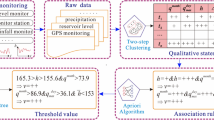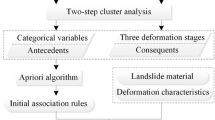Abstract
Understandings of reinforcement mechanisms of landslide-stabilizing pile system are important for long-term safety of reservoir landslides installed piles. The paper proposes a framework to study deformation response and identify triggering factors for landslide–pile system by using geographic detector technology and uncertainty of monitoring data. Majiagou landslide, a representative reservoir landslide installed stabilizing and test piles, is selected as the case study. Firstly, monitoring data of monthly rainfall, variations of reservoir water level, deformation of landslide surface and piles’ head were preprocessed. The random deformation data were generated considering uncertainty of deformation monitoring data. Meanwhile, the deformation response of landslide–pile system is analyzed through studying the monitoring deformation data and random deformation data using the clustering algorithm. Finally, geographic detector technique was used to identify main triggering factors of landslide surface deformation and explore interaction types of any two factors. The uncertainty of monitoring data was used to identify the most important triggering factor. Influences of different error and uncertainty of monitoring data on the influence degrees of each factor were further discussed. The comparison with improved Apriori algorithm shows that the presented framework can intuitively measure influence degrees of each factor and analyze interaction types of any two factors. The main conclusions by studying Majiagou landslide indicate that the anti-slide performance and action range of piles gradually decrease with the increase of hydraulic cycle; the deterioration of geomaterials’ properties are the most important triggering factor leading to the deformation of landslide–pile system and the degradation of piles’ performance, supported by most random deformation groups.
Similar content being viewed by others
References
Chen XZ, Cui YF (2017) The formation of the Wulipo landslide and the resulting debris flow in Dujiangyan City, China. J Mt Sci 14(6):1100–1112. https://doi.org/10.1007/s11629-017-43921
Cheng CW, Lin CC, Leu SS (2010) Use of association rules to explore cause-effect relationships in occupational accidents in the Taiwan construction industry. Saf Sci 48(4):436–444. https://doi.org/10.1016/j.ssci.2009.12.005
Cui YF, Chan D, Nouri A (2017) Coupling of solid deformation and pore pressure for undrained deformation-a discrete element method approach. Int J Numer Anal Methods 41(18):1943–1961. https://doi.org/10.1002/nag.2708
General Administration of Quality Supervision, Inspection and Quarantine of the People’s Republic of China, Standardization Administration (2009) Specification for global positioning system (GPS) surveys. Standards Press of China, Beijing, pp 2–3
Guo WD (2015) Nonlinear response of laterally loaded rigid piles in sliding soil. Can Geotech J 52(7):903–925. https://doi.org/10.1139/cgj-2014-0168
Hu XL, Zhang M, Sun MJ, Huang KX, Song YJ (2013) Deformation characteristics and failure mode of the Zhujiadian landslide in the Three Gorges Reservoir, China. Bull Eng Geol Environ 74(1):1–12. https://doi.org/10.1007/s10064-013-0552-x
Hu XL, Tan FL, Tang HM, Zhang GC, Su AJ, Xu C, Zhang YM, Xiong CR (2017) In-situ monitoring platform and preliminary analysis of monitoring data of Majiagou landslide with stabilizing piles. Eng Geol 228:323–336. https://doi.org/10.1016/j.enggeo.2017.09.001
Huang ZQ, Law KT, Liu HD, Jiang T (2009) The chaotic characteristics of landslide evolution: a case study of Xintan landslide. Environ Geol 56:1585–1591. https://doi.org/10.1007/s00254-008-1256-6
Li CD, Tang HM, Hu XL, Wang LQ (2013) Numerical modelling study of the load sharing law of anti-sliding piles based on the soil arching effect for Erliban landslide, China. KSCE J Civ Eng 17(6):1251–1262. https://doi.org/10.1007/s12205-013-0074-x
Li CD, Tang HM, Ge YF, Hu XL, Wang LQ (2014) Application of back-propagation neural network on bank destruction forecasting for accumulative landslides in the three Gorges Reservoir Region, China. Stoch Environ Res Risk Assess 28(6):1465–1477. https://doi.org/10.1007/s00477-014-0848-9
Li SL, Xu Q, Tang MG, Lqbal J, Liu J, Zhu X, Liu FZ, Zhu DX (2018) Characterizing the spatial distribution and fundamental controls of landslides in the Three Gorges Reservoir area, China. Bull Eng Geol Environ 78(6):4275–4290. https://doi.org/10.1007/s10064-018-1404-5
Li CD, Fu ZY, Wang Y, Tang HM, Yan JF, Gong WP, Yao WM, Criss RE (2019a) Susceptibility of reservoir-induced landslides and strategies for increasing the slope stability in the Three Gorges Reservoir Area: Zigui Basin as an example. Eng Geol 261:105279. https://doi.org/10.1016/j.enggeo.2019.105279
Li CD, Yan JF, Wu JJ, Lei GP, Wang LQ, Zhang YQ (2019b) Determination of the embedded length of stabilizing piles in colluvial landslides with upper hard and lower weak bedrock based on the deformation control principle. Bull Eng Geol Environ 78(2):1189–1208. https://doi.org/10.1007/s10064-017-1123-3
Li HJ, Xu Q, He YS, Fan XM, Li SL (2019c) Modeling and predicting reservoir landslide displacement with deep belief network and EWMA control charts: a case study in Three Gorges Reservoir. Landslides 17(3):693–707. https://doi.org/10.1007/s10346-019-01312-6
Lin Q, Wang Y (2018) Spatial and temporal analysis of a fatal landslide inventory in China from 1950 to 2016. Landslides 15(12):2357–2372. https://doi.org/10.1007/s10346-018-1037-6
Liu DZ, Cui YF, Guo J, Yu ZL, Chan D, Lei MY (2020) Investigating the effects of clay/sand content on depositional mechanisms of submarine debris flows through physical and numerical modeling. Landslides 17(8):1863–1880. https://doi.org/10.1007/s10346-020-01387-6
Luo W, Liu CC (2018) Innovative landslide susceptibility mapping supported by geomorphon and geographical detector methods. Landslides 15(3):465–474. https://doi.org/10.1007/s10346-017-0893-9
Ma JW, Tang HM, Hu XL, Bobet A, Zhang M, Zhu TW, Song YJ, Eldin MAME (2016) Identification of causal factors for the Majiagou landslide using modern data mining methods. Landslides 14(1):311–322. https://doi.org/10.1007/s10346-016-0693-7
Michailidou C, Maheras P, Arseni-Papadimititriou A, Kolyva-Machera F, Anagnostopoulou C (2009) A study of weather types at Athens and Thessaloniki and their relationship to circulation types for the cold-wet period, part I: two-step cluster analysis. Theor Appl Climatol 97(1–2):163–177. https://doi.org/10.1007/s00704-008-0057-x
Nahar J, Imam T, Tickle KS, Chen YPP (2013) Association rule mining to detect factors which contribute to heart disease in males and females. Expert Syst Appl 40(4):1086–1093. https://doi.org/10.1016/j.eswa.2012.08.028
Sharafi H, Sojoudi Y (2016) Experimental and numerical study of pile-stabilized slopes under surface load conditions. Expert Syst Appl 14(4):221–232. https://doi.org/10.1007/s40999-016-0017-2
Su LJ, Hu KH, Zhang WF, Wang J, Lei Y, Zhang CL, Cui P, Pasuto A, Zheng QH (2017) Characteristics and triggering mechanism of Xinmo landslide on 24 June 2017 in Sichuan, China. J Mt Sci 14(10):1689–1700. https://doi.org/10.1007/s11629-017-4609-3
Tang HM, Wasowski J, Juang CH (2019) Geohazards in the three Gorges Reservoir Area, China Lessons learned from decades of research. Eng Geol 261:105267. https://doi.org/10.1016/j.enggeo.2019.105267
Wang JF, Hu Y (2012) Environmental health risk detection with GeogDetector. Environ Model Softw 33:114–115. https://doi.org/10.1016/j.envsoft.2012.01.015
Wang JF, Li XH, Christakos G, Liao YL, Zhang T, Gu X, Zheng XY (2010) Geographical detectors-based health risk assessment and its application in the neural tube defects study of the Heshun region, China. Int J Geogr Int Sci 24(1):107–127. https://doi.org/10.1080/13658810802443457
Wang JF, Zhang TL, Fu BJ (2016) A measure of spatial stratified heterogeneity. Ecol Indic 67:250–256. https://doi.org/10.1016/j.ecolind.2016.02.052
Wei G, Shuang D, Xin C (2020) Landslide prediction based on a combination intelligent method using the GM and ENN: two cases of landslides in the Three Gorges Reservoir, China. Landslides 17:111–126. https://doi.org/10.1007/s10346-019-01273-w
Wu Q, Tang HM, Ma XH, Wu YP, Hu XL, Wang LQ, Criss R, Yuan Y, Xu YJ (2018) Identification of movement characteristics and causal factors of the Shuping landslide based on monitored displacements. Bull Eng Geol Environ 78(3):2093–2106. https://doi.org/10.1007/s10064-018-1237-2
Xue Y, Wu YP, Miao FS, Li LW, Liao K, Ou GZ (2020) Effect of spatially variable saturated hydraulic conductivity with non-stationary characteristics on the stability of reservoir landslides. Stoch Environ Res Risk Assess 34(2):311–329. https://doi.org/10.1007/s00477-020-01777-1
Yao WM, Li CD, Zuo QJ, Zhan HB, Criss RE (2019) Spatiotemporal deformation characteristics and triggering factors of Baijiabao landslide in Three Gorges Reservoir region, China. Geomorphology 343:14–47. https://doi.org/10.1016/j.geomorph.2019.06.024
Yao WM, Li CD, Zhan HB, Zhang HW, Chen WQ (2020a) Probabilistic multi-objective optimization for landslide reinforcement with stabilizing piles in Zigui Basin of Three Gorges Reservoir region, China. Stoch Environ Res Risk Assess 34(6):807–824. https://doi.org/10.1007/s00477-020-01800-5
Yao WM, Li CD, Zhan HB, Zhou JQ, Criss RE, Xiong S, Jiang XH (2020b) Multiscale study of physical and mechanical properties of sandstone in Three Gorges Reservoir region subjected to cyclic wetting-drying of Yangtze River water. Rock Mech Rock Eng 53:2215–2231. https://doi.org/10.1007/s00603-019-02037-7
Yin YP, Huang BL, Chen XT, Liu GN, Wang SC (2015) Numerical analysis on wave generated by the Qianjiangping landslide in three Gorges Reservoir, China. Landslides 12(2):355–364. https://doi.org/10.1007/s10346-015-0564-7
Yin YP, Li B, Wang WP, Zhan LT, Xue Q, Gao Y, Zhang N, Chen HQ, Liu TK, Li AG (2016) Mechanism of the December 2015 catastrophic landslide at the Shenzhen landfill and controlling geotechnical risks of urbanization. Engineering 2(2):230–249. https://doi.org/10.1016/J.ENG.2016.02.005
Zhang YM, Hu XL, Tannant D, Zhang GC, Tan FL (2018) Field monitoring and deformation characteristics of a landslide with piles in the Three Gorges Reservoir area. Landslides 15(3):581–592. https://doi.org/10.1007/s10346-018-0945-9
Zhang L, Shi B, Zhang D, Sun YJ, Inyang HI (2020a) Kinematics, triggers and mechanism of Majiagou landslide based on FBG real-time monitoring. Environ Earth Sci 79:200. https://doi.org/10.1007/s12665-020-08940-5
Zhang YG, Zhang Z, Xue S, Wang RJ, Xiao M (2020b) Stability analysis of a typical landslide mass in the Three Gorges Reservoir under varying reservoir water levels. Environ Earth Sci 97(1):42. https://doi.org/10.1007/s12665-019-8779-x
Zhou JQ, Wang LC, Li CD, Tang HM, Wang LQ (2020) Effect of fluid slippage on eddy growth and non-Darcian flow in rock fractures. J Hydrol 581:124440. https://doi.org/10.1016/j.jhydrol.2019.124440
Zou ZX, Yang YM, Fan ZQ, Tang HM, Zou M, Hu XL, Xiong CR, Ma JW (2020) Suitability of data preprocessing methods for landslide displacement forecasting. Stoch Environ Res Risk Assess 34(8):1105–1119. https://doi.org/10.1007/s00477-020-01824-x
Acknowledgements
The work was supported by the National Key R&D Program of China (Nos. 2018YFC1507200 and 2017YFC1501304), National Science Fund for Excellent Young Scholars of China (No. 41922055), the Key Program of National Natural Science Foundation of China (Nos. 41630643 and 41931295), and the Fundamental Research Funds for the Central Universities, China University of Geosciences (Wuhan) (Nos. CUGCJ1701 and CUGGC09).
Author information
Authors and Affiliations
Corresponding authors
Additional information
Publisher's Note
Springer Nature remains neutral with regard to jurisdictional claims in published maps and institutional affiliations.
Appendices
Appendix 1: The equations of distance between clusters and threshold for Clustering algorithm
The equations of distance d(j, s) between clusters j and s in Euclidean n-space is
where, xi and yi are the coordinates of the centroids of clusters j and s.
The distance threshold C can be presented as:
where, K is the total number of all input quantitative records, J is the total number of quantitative variables in cluster j, and \(\delta_{jk}^{2}\) is the estimated variance of the kth quantitative variable in cluster j.
Appendix 2: The equations of the extent that factor X to explain the spatial stratified heterogeneity of property Y for geographical detector technique
Factor detector can probe the spatial stratified heterogeneity of Y and probe the extent of factor X to explain the spatial stratified heterogeneity of property Y. The extent q can be measured by:
where, h = 1, 2, …, L is the strata (classification or partition) of variable Y or factor X; Nh and N are units of strata h and the whole region, respectively; \(\sigma_{h}^{2}\) and \(\sigma_{h}^{{}}\) are the variances of Y values of strata h and the whole region, respectively; SSW and SST are within sum of squares and total sum of squares.
Appendix 3: The equations of support, confidence and lift in Apriori algorithm
The support of X ⇒ Y is the frequency of occurring patterns and is defined as:
The confidence of X ⇒ Y is defined as:
The lift of X ⇒ Y is defined as:
In these expressions, |T(X∪Y)| is the total number of times that both itemsets X and Y are found in the transaction database T, |T(X)| is the total number of times that itemset X is found in the transaction database T, |T(Y)| is the total number of itemsets Y in the transaction database T, and |T| is the total number of records in the transaction database T.
Rights and permissions
About this article
Cite this article
Zhang, H., Li, C., Hu, X. et al. Deformation response and triggering factors of the reservoir landslide–pile system based upon geographic detector technology and uncertainty of monitoring data. Stoch Environ Res Risk Assess 35, 1481–1498 (2021). https://doi.org/10.1007/s00477-020-01889-8
Accepted:
Published:
Issue Date:
DOI: https://doi.org/10.1007/s00477-020-01889-8














